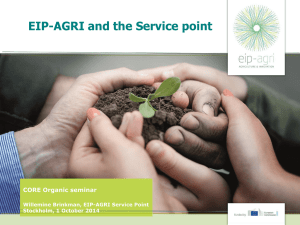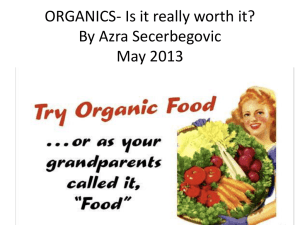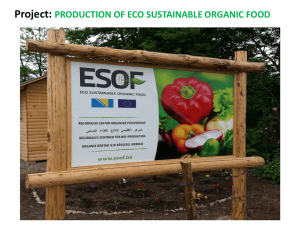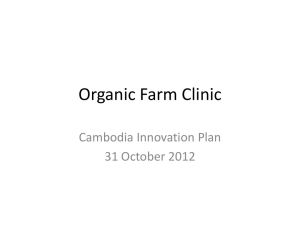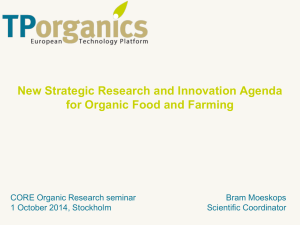ppt-10-organic-agriculture - module 3 - EN
advertisement
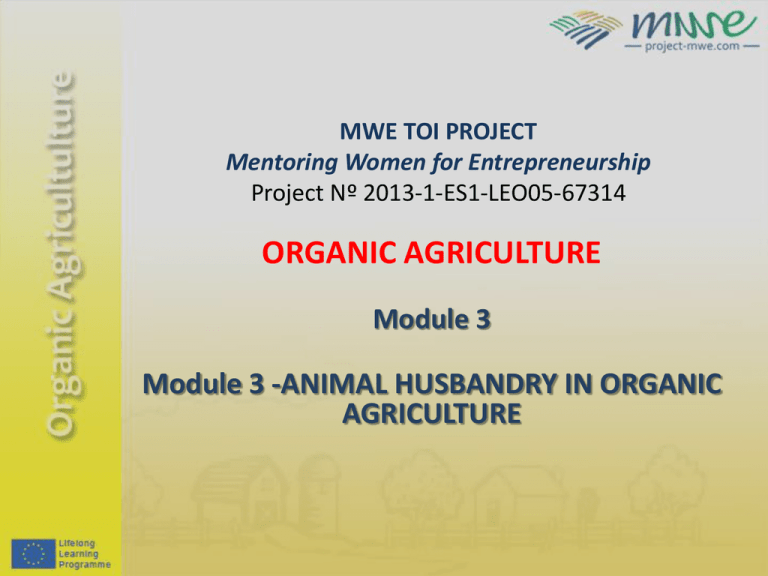
MWE TOI PROJECT Mentoring Women for Entrepreneurship Project Nº 2013-1-ES1-LEO05-67314 ORGANIC AGRICULTURE Module 3 Module 3 -ANIMAL HUSBANDRY IN ORGANIC AGRICULTURE ANIMAL HUSBANDRY IN ORGANIC AGRICULTURE Content: 1. Animal species suitable for organic agriculture 1.1. Conversion criteria and conditions used for organic livestock farming 1.2. Animal species and breeds adapted to organic agriculture system 2. Feeding animals in organic agriculture conditions 2.1. Conversion criteria for pastures 2.2. Organic fodder and administration CANIMAL HUSBANDRY IN ORGANIC AGRICULTURE 3. Providing care for animals in organic agriculture conditions 3.1. Resizing shelters and paddocks 3.2. Hygiene of the shelters 3.3. Techniques and tools for animal care 4. Specific rules of biosecurity, welfare and environmental protection in organic livestock farms Learning outcomes • The course participant is able to identify the animal species that are suitable for organic livestock farming and exploitation • The course participant knows the criteria for converting the livestock to organic farming conditions • The course participant is able to feed the animals in organic agriculture conditions • The course participant is able to provide care for animals in organic agriculture conditions • The course participant knows and is able to apply specific rules of biosecurity, welfare and environmental protection in organic livestock farms 1.1. Conversion criteria and conditions used for organic livestock farming The conversion supposes: applying a management system that ensures THE WELFARE OF ANIMALS, namely: 1. 2. 3. 4. 5. 6. Sufficient and balanced food, based on grazing and fodder Adequate loading of animals, without overgrazing Animal housing and hygiene Careful treatment Prophylaxis External resources ecological 1.1. Conversion criteria and conditions used for organic livestock farming The conversion in livestock production includes simoultaneously: A. The conversion of the land for the livestock production. B. The conversion of animals. DURATION OF THE CONVERSION OF ANIMALS AND ANIMAL PRODUCTS HORSE AND CATTLE FOR MEAT PRODUCTION 12 months SMALL RUMINANTS 6 months MILK COWS 6 months PIGS 6 months POULTRY FOR EGG PRODUCTION 6 weeks POULTRY FOR MEAT PRODUCTION 10 weeks BEES IN THE CONVENTIONAL SYSTEM 1 year Maximum number of animals per ha. overgrazing Nª/ Ha ( 170kg. N /ha/ year ) Horses > 6 luni Milk cows Male bovines >2 years 2 Male bovines < 1 year 5 Bovines – male and female (1-2 years) 3,3 Female < 1 an 2,5 Sheep and goats 13,3 Sows 6,5 Pig meat 14 Pigs 74 Rabbits 100 Poultry meat 580 Poultry eggs 230 MINIMUM SURFACE FOR ENSURING HEALTHY AND PRODUCTIVE ANIMALS IN ORGANIC CONDITIONS MINIMUM SURFACE FOR ENSURING HEALTHY AND PRODUCTIVE ANIMALS IN ORGANIC CONDITIONS IN SHELTER OUTSIDE Horses> 6 months Oxen>2 years 5 m2/animal 33, 7 m2/animal Buffalos 10 30 Milk cows 6 4,5 Sheep and goats 1,5 2,5 Breeding pigs 6 8 Pg meat 1.3 1 Pigs O,6 m2/c 0,4 m2/c Poultry 6 c/m2 Eggs 10 c/ m2 LIVESTOCK PRODUCTION IN ORGANIC CONDITIONS In order for a livestock farm to be certified as organic it needs to have: • • • • • Certified animals. Certified pastures. Certified fodder crops. Certified technological flow. Certified treatments. 1.2. Animal species and breeds adapted to organic agriculture system • Species: cattle, sheep, swine, horses, birds, small animals, bees • Breeds: locals - improved primitive, able to adapt to local conditions, vitality and their resistance to diseases and health problems. imported– refined primitive • Origin During the conversion period the animals must come from organic farms or farms under conversion. 2. Feeding animals in organic agriculture conditions The key point of livestock growing in extensive system refers to animal density that may not exceed 2 LU (livestock units) per hectare. The density of conventional animals on pasture should not be higher than stated in the regulation, so that the amount of manure on pasture corresponds to 170 kg of nitrogen per hectare per year, in the same way as for the organic livestock. It is not allowed that organic and conventional animals graze on the same pasture at the same time. In all theses cases, the farmer must seek approval from the inspection body that needs to check the farm. 2.1. Conversion criteria for pastures • The livestock must be fed with organic products. • In the case of the mammals, the food must conform to their nutritional requirements. • The feeding must be natural; that is why young animals must be fed with whole milk, preferably maternal milk. • All mammals must be fed with natural milk for a minimum period (3 months- bovine and equine, 45 days - sheep and goats and 40 days –pig), while artificial milk is not accepted. Herbivores: • • they must be kept as long as possible on the pastures, if the weather conditions do not endanger the health of the animals (or the quality of the pastures); at least 60% of the dried substance of the daily rations must be in the form of roughage, fresh or dried fodder or silage. 2. 2. Organic fodder and administration COMPOSITION OF THE FODDER FODDER STUFF DRIED MASS ORGANIC SUBSTANCE ALBUMIN FIBERS AMIDINE AND SUGAR, CARBOHYDRATES FAT ASH (SAND, MINERALS) WATER ACTION OF NUTRIENTS GROUP OF SUBSTANCES MEANING Albumin (protein) Amino acids, proteins, non-protein nitrogen Development of of albumin in the animal body (muscle, hair, lactalbumin) Fat Fats, fatty acids Energy, development of the fat lawyer Fibers (raw fibers) Vegetal fibers, wooden material Pigs: important for digestion NfE (carbohydrates) Sugar, amidine Energy for the metabolism ADMINISTRATION OF ORGANIC FODDERS MIX FOR VEALS: MIX FOR FATENNING PIGS UP TO 60 KG Cereals 30 % Wheat 45 % Soy groats 22 % Vegetable oil 1% Mineral supliment 2% MIX FOR POULTRY Corn Wheat and barley Soy and sunflower groats + alfalfa Natural additives (salt, calcium, phosphorus, vitamins and minerals from rocks) 50 % 25 % 20 % 5% Corn 40 % Oat Bran Soy groats Salt Calcium carbonate 30 % 20% 8% 1% 1% FOOD FOR THE HERBIVORES • In the case of herbivores, except during the annual transhumance, according to Regulation (EC) no. 889/2008, Article 17 (4), at least 50% of the feed shall come from the farm unit itself or, if not possible, are produced in cooperation with other organic farms mainly located in the same region. • The systems for growing herbivores are based on the maximum use of grazing pasturage according to the availability of pastures in the different periods of the year. • At least 60% of the dry matter in daily rations of herbivores shall consist of roughage, fresh or dried silage. • It is allowed a reduction to 50% for animals in dairy production for a maximum period of three months at the beginning of the lactation period. BREEDING • The organic livestock farming promotes native breeds and hybrids, with great natural strength, good breeding indices, high vitality and joint productions. • Utmost importance is given to qualitative characteristics of production and not the quantity. • It is forbidden the use of artificial induction of polyploidy, artificial hybridisation, cloning and production mono-sex lines, except manual selection. • Specific conditions for each species are established as regards the management of genitors, reproduction and production of young livestock. 3. Providing care for animals in organic agriculture conditions 3.1. Resizing shelters and paddocks Shelters: big, east-oriented Density will ensure animal welfare, giving them enough space to sit comfortably upright, lie down easily, turn round, to allow any position and any natural movement, such as: lying down for the cattle and wings beating of birds. The minimum surface for indoor and outdoor areas and other characteristics of housing for different species and categories of animals are set out in Annex III of Regulation (EU) 889/2008. Paddocks: increased brightness coefficient. 3.2. Hygiene of the shelters During the conversion period, the norms of the Regulation (CE) no. 834/2007 and 889/2009 must be applied. It is forbidden: • the use of allopathic veterinary medicinal products obtained by chemical synthesis or antibiotics for preventive treatments. • substances to stimulate growth or production and the use of hormones or similar substances to control reproduction or for other purposes. The shelters, enclosures, equipment and utensils must be properly cleaned and disinfected to prevent infection and emergence of disease carrying organisms. The excrements, urine and uneaten or spilled food must be removed as often as necessary to minimize smell and to avoid attracting insects or rodents. To eliminate insects and other pests in buildings and other facilities where animals are kept, it is possible to use only products listed in Annex VII to R (EC) no. 834/2007. When the animals sick or injured, they will be treated immediately, if necessary in isolation and in suitable housing. 3.3. Techniques and tools for animal care 3.3.1. Body hygiene Species Operatio Necessary n materials Cattle Bandage - wisp of Horses straw - harrow - brush - cloth (sponge) - comb - scissors - special brush Tasks to be done - rubbing with straw wisp - the soft parts are rubbed down, from head to tail, except bone angles of a body region - the hair is brushed up and back in order to remove dust and dirt, with a special brush, from the head to the tail region - the bone angles are cleaned with a brush - the whole body is cleaned with a cloth wipe from head to tail to remove dust and give characteristic luster - for the horses, the topknot, mane and tail should be brushed - for the cattle, the tail should be brushed 3.3.2 Health conditions of animals – Treatment Herbal products, homeopathic treatment and oligoelements are preferred to the antibiotics or the allopathic chemically synthesized veterinary treatments, provided that their therapeutic effect is effective. If they are ineffective, antibiotics and allopathic chemically synthesized products may be used under the responsibility of a veterinarian. With the exception of vaccines, treatments for parasites and compulsory eradication schemes, when an animal or group of animals receive more than three series of treatments with allopathic chemically synthesized products or antibiotics within 12 months, or more than one treatment if their productive life cycle is less than one year, such animals or products derived from them cannot be considered organic, and the livestock shall undergo the conversion periods. 4. Specific rules of biosecurity, welfare and environmental protection in organic livestock farms To avoid contamination of soil with manure, it is not allowed to set up a livestock farm unless there is adequate land area required for the number of animals, depending on the species. Under Article 3 (3) of Regulation (EC) 889/2008, livestock production is prohibited without land, when the owner does not manage the agricultural land and / or has not established a written cooperation agreement with another operator . For the grassland used for the grazing herbivores, the regulation prohibits increasing the load of animals per hectare, the maximum number of heads must be established so that that the amount of nitrogen as manure does not exceed 170 kg / ha. This limit applies exclusively for the use of manure, dry manure and dehydrated poultry manure, compost of animal excrements, including poultry manure, compost of manure and liquid animal excrements. Manure from animals under conversion will be administered on lands under conversion or in conventional agriculture. BIBLIOGRAPHY 1. Council Regulation (EC) No. 834/2007 of 28 June 2007 on organic production and labelling of organic products and repealing Regulation (EEC) No. 2092/91; 2. Commission Regulation (EC) No. 889/2008 laying down detailed rules for the implementation of Council Regulation (EC) No. 834/2007 on organic production and labelling of organic products with regard to organic production, labelling and control. 3. Organic agriculture manual, (course handbook), Ion Toncea Enuţă Simion, Georgeta Ioniţă Niţu, Daniela Alexandrescu Vladimir Adrian Toncea 4. Organic technologies in husbandry, Mariana Gherman, Printing house: Risoprint, 2012



